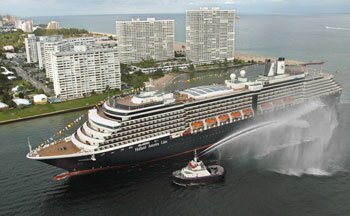|
Cruise Essentials:
|

Don't pay more than your tablemates...
CruiseCompete makes it easy to let independent agents compete to offer you the best deal.
|
Cruisers' favorites:

Cruise Travel

Porthole

Have a question or a review to submit? Write to
Copyright © 1995-2013
Linda Coffman,
CruiseDiva.com (SM)
ALL RIGHTS RESERVED
All CruiseDiva.com content is protected by United States Copyright Laws. Violators of our copyright, as well as bandwidth theft by "direct linking" of images, will be pursued by all means necessary. Find out more in
Terms of Service
|
Holland America Line’s Zuiderdam
Cruise the Southern Caribbean & Panama Canal,
Easily & Conveniently
 By Georgina Cruz By Georgina Cruz
This spring, my husband Humberto and I wanted to explore off-the-beaten paths islands of the Southern Caribbean, South and Central America, and the Panama Canal from Florida—but we wanted to do so conveniently and in a relaxed way, unpacking only once, and above all, without having to fly. “The journey of a thousand miles begins with one step,” Lao Tzu, the Chinese philosopher, noted—we just did not want that first step to be at the airport. It was simple! We booked an 11-day Panama Canal Sunfarer voyage on Holland America’s Zuiderdam, roundtrip from Fort Lauderdale.
The relaxation started right away: we were no sooner unpacked than the ship was dropping anchor in the aquamarine waters of Half Moon Cay, Holland America’s private island in the Bahamas. Just the mere sight of this idyll with its aquamarine waters and arching white sands is enough to put anyone on a laid-back mood, ready to live out an upscale Robinson Crusoe fantasy. We splurged on a private cabana to enjoy the day to the max. Our cabana, number 3, has a mini refrigerator and ice bucket, two super-comfy lounge chairs, café table and four chairs, fresh water shower, beach towels, and for the ultimate cool treat, an air-conditioner unit, ceiling fan and a revolving fan on the porch to redirect the cold air from the air-conditioner back into the cabana. We had a veggie platter, fruit platter, bottled water and sodas awaiting us in our fridge—as well as salsa for the provided basket of chips. It was a delight just to while away a morning snorkeling (equipment included), and after a tropical lunch, spend part of the afternoon lounging on provided floats in the warm embrace of the crystalline water of the crescent beach. Ah, bliss!
Half Moon Cay, by the way, recently celebrated its 15th anniversary with various enhancements, including new two-story Beach Villas with private whirlpools for a super-luxurious island oasis.
“The fondest wish of our Caribbean guests is to return to Half Moon Cay. It’s their favorite port of call,” observed Matthew Sams, vice president, Caribbean Relations, Holland America. Amen to that—Humberto and I can’t wait to return!
After our call at Half Moon Cay, we had a sybaritic day at sea, enjoying the gracious interiors of the Zuiderdam, adorned with art and fresh flower arrangements; the pampering service by the staff; and the ship’s bountiful culinary offerings. The dinner menus are among the most extensive we have ever encountered at sea with four appetizers, four soups and salads, more than a half-dozen entrees (not to mention the always-available dishes like grilled salmon, steak, and chicken breast) and a bountiful variety of desserts every evening, including an always-available brownie stack (Yum! Yum!).
We patronized The Greenhouse Spa, with its heavenly hydro-pool and got a pass to use it during the whole voyage. In fact, we would have been content with staying on board forever. But the Netherlands Antilles islands of Curacao and Aruba were like a siren call.
We made sure we were up on deck for our ship’s arrival in Curacao, as the entrance to Sint Anna Bay in Willemstad, the capital of the island, is one of the most picturesque in the Caribbean. The port channel is narrow and lined with three-century-plus-old Dutch gabled buildings in pastel tones and bright red roofs, examples of what has been called by UNESCO “tropicalized historical architecture of Dutch origin” when conferring upon it the status of UNESCO World Heritage Site. Adding to the eye appeal, there are well-preserved fortifications on either side of Sint Anna Bay, the Water Fort, built in the 17th century along with Fort Amsterdam (now Government House) on the Punda district side, and the Rif Fort on the Otrabanda district side dating back to the 19th century (Willemstad has two other historic districts, Pietermaai and Scharloo). As if all this were not enough, a pontoon bridge for pedestrians, the Queen Emma Bridge, swings aside to let ships pass.
We took a tour to enjoy the highlights of Curacao, a tiny island—just 171 square miles in dimension—that has nevertheless a wealth of culture, nature and history. The Spanish encroached upon the island and its Arawak natives in 1499; the Dutch took possession of Curacao in 1634, with a settlement created by the Dutch West India Company; and apart from two brief British occupations, the island remained Dutch colonial territory until 1955, when the Netherlands Antilles acquired self-government within the Kingdom of the Netherlands. While on our island excursion we made a stop the Dinah Veeris Botanic Gardens, a wonderful oasis filled with flowers, herbs and trees. Age-old cottages in the back of the garden are well maintained, giving visitors a feel for life in old Curacao. Other stops on the tour were made at the Riffort Village to snap a few photos from the coach of the famous “swinging old lady”—as the locals call the Queen Emma Bridge that dates from 1888—as well as the colorful Dutch colonial merchant mansions and Fort Amsterdam. A good spot to enjoy views of the pontoon bridge and the Dutch architecture is from an alfresco table at the Iguana Café along the waterfront.
The Chichis Gallery & Workshop, where local women make sculptures and paint them with bright tropical colors, is another highlight of Curacao. “Chichis,” we learned, is the nickname for the women of Curaçao, and this social project is a source of employment for local women who are proud to share this part of their culture with visitors. Before returning to the ship, we drove through the beautiful city center to view its many beautifully colored local houses and the colorful floating market. We passed by the Scharlooweg, a centuries-old residential area that historically was home to Curaçao’s wealthy merchant class. The magnificent mansions that line the streets have been meticulously restored.
Dutch-style architecture also awaited us in Oranjestad, the capital of Aruba, named after “Huis van Oranje” (the Orange House), the name of the Dutch Royal Family in 1824 during the Dutch colonization. Most of Aruba's government buildings are located in Oranjestad and the city features some traditional Dutch multicolored buildings. Some of the most picturesque Dutch colonial buildings are located in the Plaza Daniel Leo, named after a local politician and many house duty-free shops.
Other Aruba Dutch highlights include The Old Mill, a windmill that was built in 1804 in the Netherlands, taken apart and shipped to Aruba to be reconstructed in 1960. It now houses a restaurant. Another must-see is Fort Zoutman, the oldest remains of the Dutch settlement on the island that was built in 1796 as a defensive fortification against pirates and enemies. A tower, the Willem III Tower, was added to it in 1868. This tower served a dual purpose as Aruba's first public clock and as a lighthouse equipped with a spire and petrol lamp. After the light was extinguished in the tower, the fort housed government offices and other facilities, and today it houses the Historical Museum with artifacts from Aruba's earliest inhabitants to colonial times up to the present day.
An island tour took us to the California Lighthouse, about a half-hour drive from Oranjestad, on the island’s windward coast—passing arid panoramas with cacti, divi divi trees (always pointing in the direction of the trade winds) and such fauna as wild goats and iguanas. After our visit to the lighthouse, with its panoramic views of the sea, we made a stop at the bright yellow Alto Vista Chapel, the first Catholic church on the island built in 1750 on a hill overlooking the sea by Spanish missionary Domingo Antonio Silvestre. The present restored church, adorned with crosses and a statue of the Virgin Mary, has pews in the interior and semi-circular stone pews outside. It presents a serene environment for meditation and prayer.
Nature highlights on our excursion included the "baby" natural bridge, where the sea has carved an arch out of the islands’ coral, and the collapsed original natural bridge that was arguably Aruba’s favorite natural icon before it fell, as well as the Casibari Rock Formations, where giant boulders lie heaped about the landscape as if thrown about by a gigantic hand.
The Dutch influences of these ports were echoed onboard the Zuiderdam: The afternoon before our call at Aruba, we enjoyed a Royal Dutch Tea in the elegant Vista Dining Room. This special themed tea showcases a bountiful spread of typical Dutch pastries—almond cookies, anyone?—in the vestibule of the restaurant adorned with an ice sculpture and vegetable and fruit carvings. After making their selections, tea-goers find a table in the dining room to enjoy them along with a variety of teas. The Royal Dutch Tea is a Holland America Line tradition offered once every cruise in addition to regular afternoon tea daily.
The Royal Dutch Tea is only one of several opportunities to “go Dutch” in a culinary way on the Zuiderdam: many specialties from Holland enhance the dinner menus in the Vista Dining Room, including delectable Dutch split pea soup.
Other ports in our itinerary included Cartagena in Colombia, where we decided to time travel to colonial times via the “time machine” of a horse and carriage. We rode in the city’s Old Town, along cobblestone streets and squares, marveling at flower-filled balconies on mansions from the times of the conquistadors. We snapped photos of the Fort of San Felipe de Barajas, dating from the 17th-century, and visited the former city dungeons at Las Bovedas, where today local artisans display their work.
A partial transit of the Panama Canal, one of the greatest engineering feats in history—a canal that stretches 48 miles from the Caribbean Sea to the Pacific Ocean on the Isthmus of Panama—took us to Gatun Lake, the largest human-made lake in the world when it was created in the early 20th century. No matter how many times one “squeezes” through the Canal’s locks on a cruise ship, it never fails to astound. Various shore excursions opportunities available included a visit to an Embera Indian village; a Panama Railway Dome Car and motorcoach ride to Colon, and a kayak tour in the Gatun Locks to Colon.
Puerto Limon, on the Caribbean side of Costa Rica, our final port before returning to Fort Lauderdale, offers a myriad adventures—everything from aerial tram rides in the rain forest canopy to white water rafting and zip lining.
IF YOU GO—For information, visit Hollandmerica.com.
More from CruiseDiva.com:
Articles & Advice
Cruise Reviews
Cruise Line Profiles
|

Order My
Latest Book
Don't Miss!
at Fodors.com
Cruises Guide & Cruise Forum
See What's New on
Cruise Diva's Blog
|
Back to the top of this page
Use keywords to search...
|
